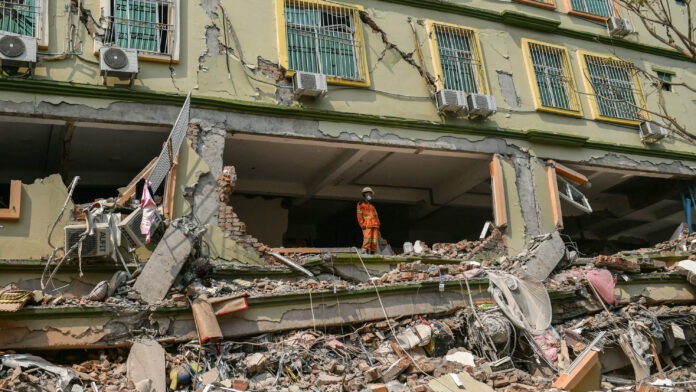Naypyidaw: The death toll from the 7.7 magnitude earthquake that struck central Myanmar on Friday has exceeded 1,600, according to the country’s military leaders, as reported by the New York Times.
The earthquake, which struck near Mandalay, Myanmar’s second-largest city, has left entire neighborhoods in ruins, with rescue teams racing to find survivors among the wreckage of collapsed buildings, monasteries, and mosques.
Rising Casualties & Rescue Challenges
The number of fatalities is expected to increase, with preliminary US Geological Survey (USGS) estimates suggesting the death toll could surpass 10,000.
Rescue efforts are hindered by:
🔴 Damaged infrastructure and power outages
🔴 Limited access to affected areas
🔴 Military-imposed information restrictions
Despite these challenges, volunteers and emergency workers continue to dig through the debris, hoping to find survivors.
Crisis Amid Political Unrest
The disaster has intensified concerns about Myanmar’s military-led government, which has been embroiled in a civil war since the 2021 coup.
Even as the earthquake devastated communities, Myanmar’s military launched airstrikes on Naung Lin, a rebel-held village in Shan State.
In response, the National Unity Government (NUG)—Myanmar’s shadow government—announced a two-week pause on offensive military operations in quake-hit areas. However, they reserved the right to defend themselves.
Public Outrage & Humanitarian Struggles
Anger is mounting against the military junta, with reports of soldiers and police officers arriving at disaster sites but failing to assist.
“We don’t need guns; we need helping hands and kind hearts,” frustrated volunteers told the New York Times.
The military has declared a state of emergency in six affected regions, including rebel-controlled areas. Senior Gen. Min Aung Hlaing visited disaster sites and a makeshift hospital in Naypyidaw on Friday.
International Aid & Relief Efforts
Despite sanctions and the junta’s global isolation, the military government has made an urgent appeal for international assistance. However, aid efforts face major logistical hurdles, including:
🔸 Collapsed infrastructure blocking aid routes
🔸 Divided regions due to ongoing conflict
🔸 Sanctions complicating fund transfers
The earthquake has also affected neighboring countries, with reports of building collapses in Bangkok, Thailand.
As Myanmar struggles with the disaster’s aftermath, humanitarian organizations and volunteers continue to push for more aid, relief efforts, and global attention to the crisis.


